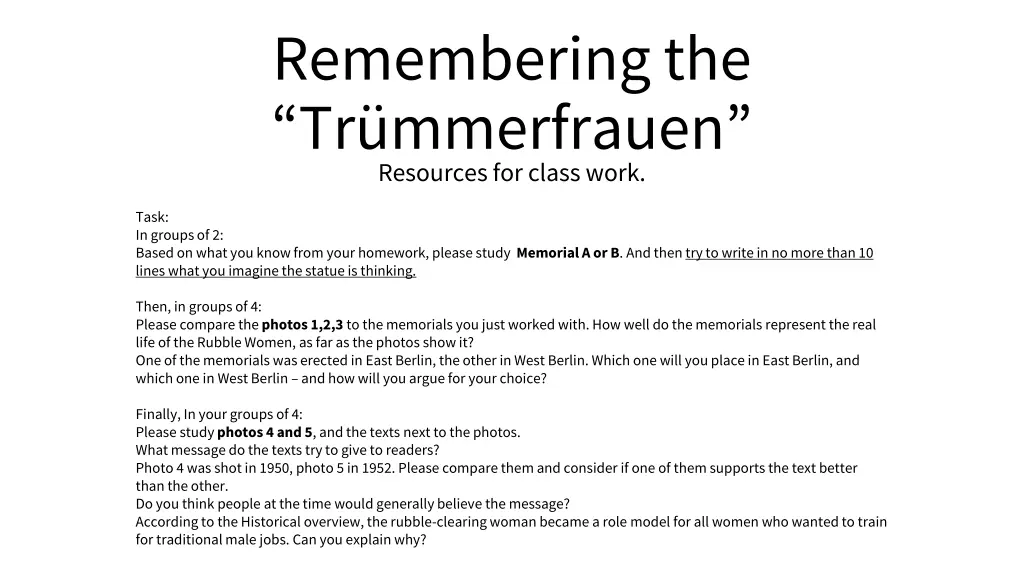
Trümmerfrauen Memorials and Historical Comparison
Explore the significance of Trümmerfrau memorials in Berlin, comparing real-life photos to these monuments. Delve into the messages portrayed in historical texts and how they influenced societal perceptions. Understand the role of Trümmerfrauen as trailblazers for women entering traditional male-dominated professions.
Download Presentation

Please find below an Image/Link to download the presentation.
The content on the website is provided AS IS for your information and personal use only. It may not be sold, licensed, or shared on other websites without obtaining consent from the author. If you encounter any issues during the download, it is possible that the publisher has removed the file from their server.
You are allowed to download the files provided on this website for personal or commercial use, subject to the condition that they are used lawfully. All files are the property of their respective owners.
The content on the website is provided AS IS for your information and personal use only. It may not be sold, licensed, or shared on other websites without obtaining consent from the author.
E N D
Presentation Transcript
Remembering the Tr mmerfrauen Resources for class work. Task: In groups of 2: Based on what you know from your homework, please study Memorial A or B. And then try to write in no more than 10 lines what you imagine the statue is thinking. Then, in groups of 4: Please compare the photos 1,2,3 to the memorials you just worked with. How well do the memorials represent the real life of the Rubble Women, as far as the photos show it? One of the memorials was erected in East Berlin, the other in West Berlin. Which one will you place in East Berlin, and which one in West Berlin and how will you argue for your choice? Finally, In your groups of 4: Please study photos 4 and 5, and the texts next to the photos. What message do the texts try to give to readers? Photo 4 was shot in 1950, photo 5 in 1952. Please compare them and consider if one of them supports the text better than the other. Do you think people at the time would generally believe the message? According to the Historical overview, the rubble-clearing woman became a role model for all women who wanted to train for traditional male jobs. Can you explain why?
Memorial A: 1954 CC BY-SA 3.0 File:Cremer Aufbauhelferin.jpg Hochgeladen: 18. April 2006
Memorial B: 1955 CC BY 2.5 Hinweise zur Weiternutzung File:Truemmerfrau Hasenheide, Berlin 2.JPG Erstellt: 12. Juli 2005
Photo 1: Berlin women cleaning up J gerstrasse in July 1946 Bundesarchiv, Bild 183-H29659 / CC-BY-SA 3.0
Photo 2: Berlin 1946: Rubble women recover broken bricks, which are brought to the rubble processing plant in lorries. Bundesarchiv, Bild 183-H30060 / CC-BY-SA 3.0
Photo 3: Rubble women in Berlin, 1947 Bundesarchiv, Bild 183-Z1218-317 / CC-BY- SA 3.0
Photo 4: Berlin, Rubble Woman March 8, 1950 - 40 years of International Women's Day The caption of the photo: March 8, 1950 marks the 40th anniversary of International Women's Day. For 40 years the number of women has been growing who on this day put their demands for peace and equal rights, for equal pay for equal work and better living and working conditions in the foreground. This holiday has a special meaning for the women of the German Democratic Republic, because the constitution of the German Democratic Republic guarantees the German women all rights and equality. Shown here: Ms. Beier, 45 years old, is the best rubble woman in Berlin, who will receive a medal by Minister Selbmann* on March 8, 1950. Ms. Beier works on the construction site of the former Reich Chancellery. * (The minister for Industry in the DDR) Bundesarchiv, Bild 183-S94177 / CC-BY-SA 3.0
Photo 5: Berlin, rubble woman. The caption of the photo: Hanni Stolt is honoured as an activist on May 1 Stolt, who works as a member of the Steinicke Brigade at VEB Tiefbau, is honoured as an activist on May 1st, 1952 because of her excellent work - she cleans 3,000 stones per day. Hanni Stolt is the mother of three children. st. The construction worker Hanni Bundesarchiv, Bild 183-14328-0003 / CC-BY- SA 3.0






















